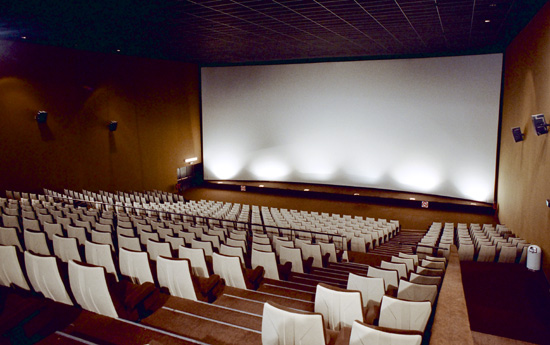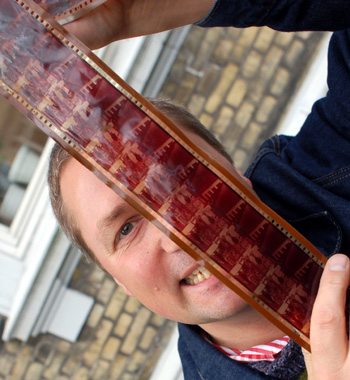How to Create the Best experience in the Cinema |
Read more
at in70mm.com The 70mm Newsletter |
| Written by: Thomas Hauerslev, and published in 1999 | Date: 19.09.1999 |
 In recent years many new cinemas with state-of-the-art sound systems, and
giant screens covering the entire front wall of the auditoria, have been
built all over the world. Yes, cinema owners know what will attract the
audience into their cinema these days. And a modern multiplex can
deliver what the audiences want: ENTERTAINMENT. In recent years many new cinemas with state-of-the-art sound systems, and
giant screens covering the entire front wall of the auditoria, have been
built all over the world. Yes, cinema owners know what will attract the
audience into their cinema these days. And a modern multiplex can
deliver what the audiences want: ENTERTAINMENT.And the audience feels good about it. They enjoy seeing the latest movies on giant screens while a perfect digital soundtrack is delivering undistorted sound, from 8 directional channels. Considering the amount of equipment installed to do all this; film projectors, speakers, amplifiers, lenses, comfortable chairs, screens etc, etc, the audiences do get value for their ticket in 1999. The experience couldn't be better.... Or could it? Is the audience getting the best presentation for their money? No, they are not. I would suggest that a visit to the cinema could be better. Not just marginally better, but an ENTERTAINMENT EXPERIENCE several times better! The cinema industry has focused on digital delivery of sound in the cinema for the past several years, and the sound reproduction has improved enormously. Today, it can't be better, provided of course, that you have the necessary speakers and amps installed. Sound quality is excellent now, and it's time to take a look at the picture quality. Modern screen sizes are up to 30 meters wide, and in some cases often slightly curved. 35mm films just can't be projected on a screen like that, without a significant loss of apparent detail and resolution. It is impossible. The result often is a fuzzy and out-of-focus picture, weaving and jumping up and down and from side to side. If you settle for a screen width around 13 - 17 meters you are within the safe limits of what a 35mm picture can do. But beyond that, forget it if you want a perfect picture. It's like driving 170 km/hour on the motor way in a Fiat Uno with a little engine. It can be done, but the ride will be bumpy, the noise will be intolerable and the whole experience not very good. The drive will be much more enjoyable smoother if you drive a Rolls Royce with a large engine. The only solution at present is to use 70mm prints. The image on a 70mm print is 3 times the area of anamorphic 35mm. With a 70mm image it is not necessary to magnify the picture nearly as much as a 35mm picture. The improved quality is clearly visible on the screen and the audience will discover the film to be far more intense. This sensation will happen on a subconscious level because their brain will have at least 3 times more picture information to "process" per second. This even happens with 35mm-to-70mm blow-ups, because of the fine-grain nature of projection stock material. A 70mm blow-up will always look better than a 35mm print, because the 70mm image contains much more information from the 35mm camera negative, compared to the 35mm print. |
More
in 70mm reading: The 2007 version P T Anderson's "The Master" in System 65 Published in the book: Film Presentation for the 21st Century - 70mm Super Definition Cinema is back! Internet link: |
 Thomas
Hauerslev, editor in70mm.com.
Self portrait. Thomas
Hauerslev, editor in70mm.com.
Self portrait.70mm can't turn a bad film into a good one, naturally, but a good film will be even better in 70mm. It will be a high-impact experience for most people and they will demand to see more 70mm once they again become aware of the special format. Cinemas showing 70mm will be sought out for their superior picture quality and soon 35mm-only cinemas will be upgrading to include 70mm equipment. That happened in the 60s, and it could happen again on one single condition: THE DEMAND FOR 70MM MUST COME FROM THE AUDIENCE AND THEATRE OWNERS. Secondly, it is the moral responsibility of the producers, directors, cinematographers and finally exhibitors to deliver the best possible experience when we go to the movies! If they don't, audiences will disappear and cinemas will close. As the editor of "..in 70mm - The 70mm Newsletter" I receive mail from all over the globe. I hear frequent stories about happy cinema owners who run 70mm films. Usually they have a full house for special performances of oldies-but-goodies like "2001: A Space Odyssey" or "Ben Hur". The audiences seem to enjoy coming back to see these old movies again and again, once the movies are shown on a curved screen in 70mm. And why are movie lovers sometimes driving 4-5 hours to see an old flick they easily could find for a nickel in the nearest video shop? Ill tell you why. Because it is shown in 70mm with 6-track stereo. Films like "Titanic" and "Braveheart" should have been shot in 65mm simply because they are "big" movies. But shooting in 65mm doesn't need to be limited to the obvious mega productions. Small independent movies would benefit enormously with the sharper picture. I'd enjoy seeing films like "Enemy of the State", "As Good As It Gets" and "You've Got Mail" and many more, shot on 65mm stock and presented in 70mm. I and most of our readership would certainly seek out cinemas presenting films in 70mm. As mentioned earlier, it will take a demand from the audience to get 70mm back in the theatres. Actually the demand from the audiences is already there, but patrons need to complain to managers about dim fuzzy images - and in the same breath, request 70mm prints in the future. And theatre managers (this is the key) need to pass on those requests to upper management levels so that their wishes are known "upstairs"! After all, that's where the equipment and booking decisions are usually made. As I see the future of 70mm films, this is the only way it can be done. Unless of course, a miracle will happen and miracles are, as we all know, a rare thing these days. Especially when the current focus of "movie" exhibition is on developing electronic projection, and the total elimination of 35mm and 70mm prints! 70mm is an attraction that will create audience satisfaction and create a come-back effect. The tag line "...in 70mm" on the marquee signals a superior product no other motion picture or video format can match. Forget about the Spielbergs and Lucases of today. We need a new generation of filmmakers who will boldly go with 65mm cameras where no filmmakers have gone the past 30 years. They will take us to the 21st century and show us what it will be like in the cinema. |
|
|
Go: back
- top -
back issues
- news index Updated 21-01-24 |
|
